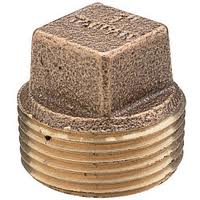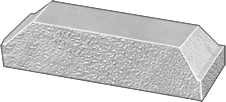Bronze - (Cu+Sn)
Melting
Point:
1562-832
Fahrenheit
\ 850-1000
CelsiusBoiling Point: Fahrenheit \ Celsius

Bronze is a metal alloy consisting primarily of copper, usually with tin as the main additive but comes in many alloy configurations each with different properties. This moderate yellowish to olive brown metal alloy is hard and brittle, but is considerably less brittle than iron. Bronze is generally harder than wrought iron, with Vickers hardness of 60–258 vs. 30–80 and is nonmagnetic.
Bronze resists corrosion (especially seawater corrosion) and metal fatigue more than steel and is a better conductor of heat and electricity than most steels. Typically bronze only oxidizes superficially once a copper oxide (eventually becoming copper carbonate) layer is formed, the underlying metal is protected from further corrosion However, if copper chlorides are formed, a corrosion-mode called "bronze disease" will eventually completely destroy it.
Bronze has very low metal-on-metal friction. Unlike steel, bronze struck against a hard surface will not generate sparks, so it (along with beryllium copper) is used to make hammers, mallets, wrenches and other durable tools to be used in explosive atmospheres or in the presence of flammable vapors.
The alloys of copper and tin and were the first to be developed about four thousand years ago. There are many different bronze alloys but modern bronze is typically 88% copper and 12% tin while Commercial bronze (90% copper and 10% zinc). Architectural bronze (57% Copper, 3% Lead, 40% Zinc) are more properly regarded as brass alloys because they contain zinc as the main alloying ingredient. They are commonly used in architectural applications. Bismuth bronze is a bronze alloy with a composition of 52% copper, 30% nickel, 12% zinc, 5% lead, 1% bismuth. It is able to hold a good polish and so is sometimes used in light reflectors and mirrors.
The addition of small amounts (0.01-0.45) of phosphorus further increases the hardness, fatigue resistance and wear resistance leading to applications such as springs, fasteners, masonry fixings, shafts, valve spindles, gears and bearings. Cast phosphor bronzes with up to 10% tin and 20% lead are widely used for heavy duty bearings.
Aluminum Bronze
These are alloys of copper with 5 - 12% aluminum, some having additions of iron, nickel, manganese and silicon, available in cast and wrought form. They are stronger than the brasses or tin bronzes with better corrosion resistance due to a hard, adherent, protective alumina film (Al2O3) They have an attractive golden color, with very little tarnishing with time. The major use for aluminum bronzes is in sea water applications, such as:
Fasteners
Pumps and valve components
Pipe fittings
Heat exchangers
Bearings
Silicon Bronze
These are alloys of copper with 3% silicon and 1% manganese. Silicon bronzes have a good combination of strength and ductility, good corrosion resistance and easy weldability. They are used in architectural applications such as:
Door fittings
Railings
Church doors
Window frames
Hinges
Wall ties
Fastener material for marine applications,
The alloy is a firm favourite with sculptors and metalsmiths because of its workability, longevity and attractive golden bronze color.
Manganese Bronze and Architectural Bronze
There may be confusion when brasses are incorrectly called bronze. Manganese bronze CuZn40Mn1Pb1 (CW720R) is a brass used for architectural applications where the manganese leads to the formation of an attractive chocolate brown color. The term 'architectural bronze' is sometimes applied to a leaded brass CuZn41Pb1Al which in service, due to the aluminum, develops an attractive golden luster. Like all brasses these alloys combine longevity with an aesthetic appeal which improves with time and they give a feeling of luxury and prestige both inside and out to any building. They are available in all forms and are used for cladding, windows, doors and curtain walls. They are usually finished by waxing.
Bronze Alloys
Bronze (copper and tin) alloy is generally ductile and malleable. Its high copper content makes it more corrosion resistant than brass. It is also harder and stronger than copper. Alloys types are
220 - Corrosion Resistant
316 - Machinable and Corrosion Resistant
510 - Ultra Strength
544 - High Strength Bearing Grade
630 - High Strength
642 - Machinable High Strength
655 - Weldable High Strength
863 - Corrosion Resistant High Strength
903 - Weldable Bearing Grade
932 - Bearing Grade
936 - Machinable Bearing Grade
954 - Corrosion Resistant Bearing Grade
SAE 64 - Machinable Bearing Grade
SAE 660 - Bearing Grade
SAE 841 - Oil-Filled Bearing GradeSilicon Bronze

About Metal Spot Prices: The spot price of metals is based on paper contracts for delivery of tons of pure metal ingots. When you're not prepared to pay for and take delivery of tons of metal ingots, that spot price will quickly become a huge understatement of the real price of that metal. When you want to buy just a few pounds of Bronze for example, you're looking at substantially higher prices. Moreover, once you own physical Bronze ingots, make absolutely sure you never sell for the spot price of Bronze. Because it's hard to get ingot grade Bronze in physical form, you've got something special on your hands and make sure to extract the full value when you're selling and understand the reverse when buying.
Bronze raw ingot source selection and prices vary greatly. An example of Silicon Bronze Alloy, In small user quantities expect to pay 14.00 to 18.00 a pound.